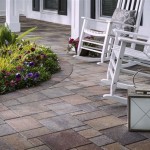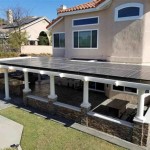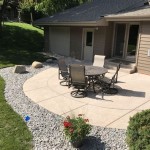How To Mix Cement For A Patio: A Comprehensive Guide
Creating a durable and aesthetically pleasing patio requires careful attention to detail, and one of the most critical aspects is properly mixing cement. The quality of the cement mixture directly impacts the strength, longevity, and overall appearance of the patio. This article provides a detailed guide on how to mix cement for a patio, covering everything from material selection to the mixing process itself.
Before beginning, it's imperative to understand the difference between cement and concrete. Cement, a fine gray powder, is a binder that, when mixed with water, aggregates (sand and gravel), and sometimes additives, forms concrete. Concrete is then used to construct various structures, including patios. Therefore, this guide focuses on mixing the concrete mixture, utilizing cement as a key ingredient.
Key Point 1: Gathering the Necessary Materials and Tools
The success of any concrete mixing project hinges on having the right materials and tools readily available. This ensures a smooth workflow and minimizes interruptions, leading to a consistent and high-quality concrete mix.
Materials:
- Portland Cement: This is the core binder and should be fresh and free from lumps. Type I Portland cement is generally suitable for general-purpose concrete work like patios.
- Fine Aggregate (Sand): Use clean, sharp sand free from clay, silt, and organic matter. These contaminants can weaken the concrete.
- Coarse Aggregate (Gravel): Choose gravel that is well-graded, meaning it contains a range of particle sizes. This improves the concrete's density and strength. The maximum size of the gravel should be appropriate for the thickness of the patio slab.
- Water: Use potable water, free from impurities that could interfere with the cement hydration process.
- Optional Additives: Air-entraining agents improve freeze-thaw resistance, while plasticizers enhance workability. Fiber reinforcement can add tensile strength. Consider these additives based on the specific climate and project requirements.
Tools:
- Mixing Container: A wheelbarrow, concrete mixing tub, or a power concrete mixer can be used. The choice depends on the scale of the project. For small patios, a wheelbarrow might suffice, while larger projects benefit from a powered mixer.
- Shovel or Hoe: These are essential for mixing the dry ingredients and incorporating water.
- Measuring Tools: Buckets, measuring cups, or a dedicated concrete measuring box are needed to accurately proportion the ingredients.
- Water Hose with Adjustable Nozzle: A hose with a controllable nozzle allows for precise water addition.
- Gloves and Safety Glasses: Protect skin and eyes from cement dust and splashes.
- Dust Mask or Respirator: Prevent inhalation of cement dust, which can irritate the respiratory system.
- Trowel: Used for smoothing and finishing the concrete surface.
- Level: Essential for ensuring a level patio surface.
- Tamper or Vibrating Plate Compactor: To consolidate the concrete and remove air pockets.
Proper material selection and tool preparation are crucial steps. Taking the time to gather everything beforehand will contribute significantly to a successful patio construction.
Key Point 2: Understanding Concrete Mix Ratios and Preparation
The strength, workability, and durability of concrete are heavily influenced by the proportions of its constituent materials. Selecting and adhering to the correct mix ratio is paramount.
Common Concrete Mix Ratios:
A common mix ratio for a patio is a 1:2:4 ratio, meaning 1 part cement, 2 parts sand, and 4 parts gravel. Another option is a 1:2.5:3.5 mix for higher strength. It's important to use consistent units of measurement (e.g., cubic feet or shovelfuls) throughout the mixing process. Pre-blended concrete mixes are also available and often simplify the process, but understanding the underlying ratio concepts remains beneficial.
Determining the Required Volume:
Before mixing the concrete, calculate the volume needed for the patio. This involves determining the length, width, and desired thickness of the patio slab. Multiply these dimensions (in feet) to get the volume in cubic feet. Add a small percentage (around 10%) to account for waste and compaction.
Dry Mixing:
Before adding water, thoroughly mix the dry ingredients (cement, sand, and gravel) in the mixing container. This ensures that the cement is evenly distributed throughout the aggregate, preventing clumps and promoting uniform hydration. Use a shovel or hoe to turn the mixture over repeatedly until a consistent color and texture are achieved.
Environment Preparation:
Moisten the area where the concrete will be poured. This prevents the dry ground from absorbing water from the fresh concrete too quickly, which can lead to cracking. Ensure the forms are properly set and leveled before pouring the concrete.
Selecting the appropriate mix ratio and meticulously preparing the ingredients and environment lays the foundation for a successful concrete pour.
Key Point 3: The Mixing Process: Achieving the Right Consistency
The actual mixing process is where the dry ingredients transform into workable concrete. Careful attention to water addition and mixing technique is essential to achieving the desired consistency and preventing common problems.
Adding Water Gradually:
Water is the catalyst that activates the cement and binds the aggregates together. However, adding too much water weakens the concrete, while too little makes it unworkable. Add water gradually to the dry mixture, mixing continuously with the shovel or hoe. Aim for a consistency similar to thick oatmeal or peanut butter. The concrete should be moist enough to be easily workable but not so wet that it slumps or separates.
Mixing Techniques (Manual):
When mixing manually in a wheelbarrow or tub, work in small batches to ensure thorough mixing. Start by creating a crater in the center of the dry mix and gradually add water while folding the dry ingredients into the water. Use the shovel or hoe to lift and turn the mixture, ensuring that all the cement is hydrated and that the aggregates are evenly distributed. Avoid over-mixing, as this can lead to segregation of the aggregates.
Mixing Techniques (Power Mixer):
If using a power concrete mixer, follow the manufacturer's instructions. Typically, you'll add the water first, followed by the cement, sand, and gravel. Allow the mixer to run for several minutes until the concrete is thoroughly mixed and has a uniform consistency. Monitor the moisture level and add small amounts of water as needed. Avoid overfilling the mixer, as this can prevent proper mixing.
Assessing the Consistency:
There are several ways to assess the consistency of the concrete. One method is the slump test, which involves placing a cone-shaped mold on a flat surface, filling it with concrete, tamping it down, and then removing the mold. The amount the concrete slumps down after the mold is removed is a measure of its consistency. For patio slabs, a slump of 3-4 inches is generally suitable. Also, observe the bleeding. If water is pooling on the surface, it indicates the mix is too wet.
Troubleshooting:
- Too Dry: If the concrete is too dry and difficult to work with, add small amounts of water and continue mixing until the desired consistency is achieved.
- Too Wet: If the concrete is too wet and soupy, add more of the dry mix (cement, sand, and gravel) in the correct proportions and continue mixing. Avoid adding just cement, as this can weaken the concrete.
- Lumps: If there are lumps of cement in the mixture, break them up with the shovel or hoe and continue mixing until they are fully incorporated.
Mastering the mixing process involves careful observation, gradual water addition, and consistent mixing to achieve the ideal concrete consistency for a durable and long-lasting patio.
With careful planning, proper material selection, and meticulous mixing techniques, achieving high-quality concrete for a patio is entirely attainable. Regular practice and attention to detail will further refine skills and ensure successful patio construction.

The Best Patio Mortar Mix For Laying Paving Slabs Simple Guide

How To Mix Mortar For Patio Laying Bradstone

Laying Courses And Bedding Materials For Flags Slabs Pavingexpert

How To Grout Paving Slabs Infinite

How To Mix Mortar Patio Paving

Diy Concrete Patio In 8 Easy Steps How To Pour A Cement Slab

The Best Patio Mortar Mix For Laying Paving Slabs Simple Guide

Jointing And Pointing For Stone Paving Dry Grouting Pavingexpert

How To Lay A Patio On Concrete Or Over Paving Marshalls

Quikrete Building A Concrete Patio
Related Posts








